How to use indoor training to smash your outdoor r
Whether you want to build endurance, become a better sprinter or improve your climbing, indoor training can help you achieve your goals on the bike.
If you’re preparing for a big summer on the bike, indoor training is the most efficient way to build your fitness and fine-tune your form for the months ahead.
Indoor training was once considered a necessary evil for cyclists, reserved for the cold, dark months of winter. However, the advent of smart trainers like the Wahoo Kickr, and indoor cycling trainer bikes such as the Wattbike Atom, alongside interactive apps including Zwift, has changed the way riders view indoor training. Dare we say it, indoor training is fun and the training benefits are plain to see.
“Indoor training allows you to follow a specific training plan far closer,” says Pav Bryan of Spokes Personal Performance Coaching. “When you’re riding out on the road, traffic, weather and unsuitable terrain can all become barriers to completing a quality training session.
That’s good news if you want to fast-track your fitness. Indoor training removes the external variables and distractions found outside, and ensures you can fit a quality session into less than an hour.
Smart devices like the Kickr and Atom can also measure your power, allowing you to train much more intelligently, and are compatible with apps that allow you to measure and track your fitness through a series of tests. Taking a fitness test will also enable you to determine your Functional Threshold Power (the maximum power you can sustain for an hour).
From there, you can set prescribed power targets for each session based on the area of fitness being targeted, with the trainer then requiring you to hold that power so you can complete quality intervals without the temptation to slack off or ride too hard.
“That means you have specificity in training,” adds Bryan. “You can really target certain power outputs to give a specific fitness adaptation, whether that’s focussing on your endurance or climbing.”
Ultimately, by incorporating indoor training into your riding schedule, you can put the building blocks in place to achieve your outdoor riding goals. After all, who doesn’t want to be stronger and faster on the road?
How to train for short, steep climbs
If you’ve got your sights set on a local Strava KOM, Jenner of Rule 5 Cycling Coaching recommends high-intensity intervals to train for punchy climbs. After a ten-minute warm-up, complete four to eight two-minute intervals at maximum intensity, with two minutes recovery between each.
If you are using a smart turbo trainer or indoor training bike, these intervals should be conducted at approximately 110 to 120 per cent of your Functional Threshold Power. Once you’ve completed your efforts, cool down for ten minutes.
“This is a great workout if you’re short on time and will improve your body’s ability to carry oxygen to your muscles when working really hard,” says Jenner.
How to improve your endurance
Indoor training might not sound like the best way to improve your endurance - after all, surely three hours on the road is better than one hour indoors? Once again, however, you’re devoid of distractions - and the opportunity to freewheel - and you can use ‘sweet spot’ intervals to make big endurance gains in a short amount of time.
“Sweet spot is generally considered to achieve positive adaptations without placing too much stress on your body, so you can repeat these intervals regularly,” says Bryan.
Your endurance sweet spot is between 83 and 97 per cent of your Functional Threshold Power (FTP) and a typical training session should include two or three intervals of ten to 20 minutes, with a ten minute break between each interval.
How to become a better sprinter
While sweet spot intervals can be used to improve your endurance, short sprints can be used to boost your top-end speed. “Start by warming up for 15 minutes, then do five 15-second, all-out sprint efforts, with five minutes of each spinning between each,” says Jenner. “The goal of this session is to improve peak power output.”
Start each sprint from a standstill, Jenner adds, and try to keep your cadence high throughout, without needing to change gears too soon (or at all). Because your sprints should be all-out efforts, this session shouldn’t be completed to a prescribed power - empty the tank each time. Finish with a 15-minute cool down.
Five pre-race fuelling tips
Individual preferences may vary but these eating and drinking guidelines apply to every cyclist, writes Aaron Borrill
Performing well on the bike is as much about fuelling correctly as it is about ensuring you’ve done the training. Riders often forget that the body is an engine and needs to be fuelled in order to perform at its optimum.
Sometimes it’s easy to get caught up in the hype of racing – particularly at the start when riders are jostling for position and the peloton is sorting itself out – but it’s here, in the first hour, where fuelling is most critical.
Failure to ensure a steady flow of energy to the muscles will have a direct impact on your performance and, more often than not, result in low blood-sugar levels and eventually the dreaded bonk. Here are five tips to ensure that you never hit the wall again.
1. Pre-race
The goal here is to replenish your liver glycogen stores. The body utilises the liver glycogen stores during sleep to maintain glucose balance.
For one-day events, an easily digestible food source is ideal to ensure that there’s nothing sitting in the stomach and small intestine when you start racing. Try two slices of white bread (toasted, if you like) with jam or honey, a banana and 500ml of commercial energy drink will suffice.
Muesli and uncooked oats, nuts and seeds can take anywhere between 8 and 12 hours to fully digest and are more suited for stage races.
You should eat 90-120 minutes before your race.
2. During the race
The amount of carbohydrates required depends on the duration of the event. As a guideline, for any race over 2 hours, aim to consume between 60-90 grams of carbohydrates per hour, as well as 500ml of fluid.
Fluid absorption and gastric emptying peak at around 500ml of fluid per hour – any more than this will pool in the gut and possibly lead to an upset stomach. Look for a mix of 2/3 maltodextrin and 1/3 fructose, which can improve carbohydrate absorption.
3. Bars, gels or fluid?
A combination of a commercial energy drink, bars or gels are most effective. While 500ml of energy drink will deliver 50g of carbohydrates per hour, gels or bars can make up the remaining 10-40g.
4. Caffeine timing
Caffeine is widely known to improve performance. Having a coffee roughly one hour before the start of a race and topping up after 2-3 hours with a caffeine gel/bar can be a useful strategy.
5. Train the gut
Your gut needs to be trained to consume carbohydrates during intense exercise. You should therefore never experiment with anything new come race day, and instead stick to the same nutrition used throughout training.
Hoy Bonaly bike Review
By: Hannah Bussey
Source
Designed in partnership with Sir Chris Hoy, the Hoy Bonaly bike promises to offer the lightest, most durable and grin inducing ride for your budding Olympian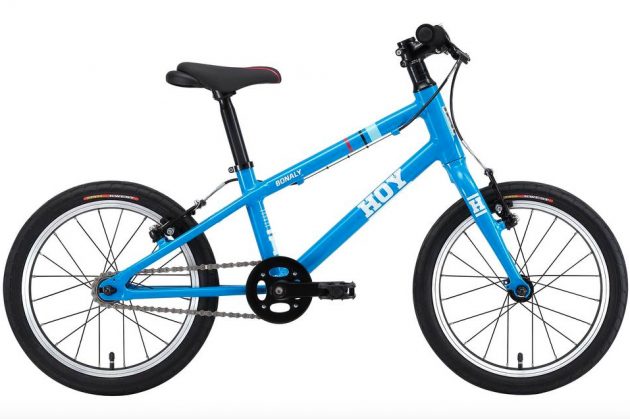
When Sir Chris Hoy launched his range of kids bikes back in April, he promised lightweight bikes and competitive prices. Named after the final down hill run on Sir Hoy’s old riding patch in Pentland Hills where Sir Chris Hoy first rode his mountain bike, the Hoy Bonaly bike range was carried over from the previous bike Evan Cycles exclusive range, but now comes with a completely redesigned lightweight frame, child friendly components and in 16, 20, 24 and 26 inch wheel sizes.
A Lightweight design was the biggest priority for Sir Hoy, who believes that if you calculated your body weight in relation to your bike, some kids bikes weights would be the equivalent of a adult bike weighing around the same as a motorbike.
With the 16″ Hoy Bonaly bike weighing in at 6.06kg (with pedals), you could argue that some adult bikes weigh less, but the second of Hoy’s priorities was cost and in order to keep the price down to £260 as apposed several thousands, there has to be compromises to be had. Besides, its a mere 250 grams heavier than the brand leading 14″ Islabike Cnoc but costs £30 less.
Made from 6061-T6 heat treated alloy, the single speed Hoy Bonaly bike comes with narrow Q factor crankset which Evan Cycles says has been designed to ensure smaller riders’ legs are closer together and pedalling is efficient and smooth on the 25/14 gear ratio.
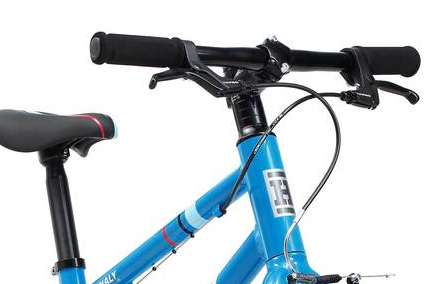
All the other components have been child friendly designed too, with the Tektro alloy mini-V brakes coming with short reach levers, narrow 450mm handlebar and 60cm stem. The 16″ single wall aluminium rimed wheels are shod in Kenda K193 tyres, and up top is a Hoy kids super light foam saddle, which comes with an integrated handle for that all important adult hold in setting off, sudden slow down grab or even just carrying it back through the park once your child has had enough of riding the bike, although it’s much more comfortable to lasso an old inner tube round the bike and carry it on the shoulder like an over sized work bag.
The Ride
Having a tall just turned four year old is tricky when it comes to bikes she’d out grown her balance bikes last summer, but has struggled with the physical leg strength to turn pedals on anything other than flat, or downhill, bike rides. She’s now at 1.07 meters, meaning she’d only really got going on her lightweight 14″ Islabike Cnoc on more uneven and undulating terrain before already being at the seat post limit and complaining of sore hands on when it was rough going under wheel. So bigger wheels, aka a new bike, was certainly required, but the added complexity and weight of gears are by no means needed just yet.
The bigger wheels of the Hoy Bonaly bike immediately helped smooth out the terrain and while leg strength is still being built in my ‘tall for age’ four year old, she seemed to be better able to deal with cycle path obstacles, such as larger stones and potholes. Bigger wheels also meant faster rolling speed, as the same 25/14 gear ratio is used on the Isla Cnoc my daughter upgraded from, however, she’s recently learnt a lot more speed moderation, so was able to control the bike at slow speeds well – but it’s worth remember when your child hops on for the first time.
The child friendly Tektro alloy mini-V brakes work well and had plenty of adjustment to allow for small hands, so there were no issues with radial grip of bars and braking, I just wish my daughter would always choose this stopping option over feet skid stops – but I guess that will come in time!
Considering the Hoy Bonaly bike is a fair bit bigger than her old one, I was really surprised at how fast my daughter mastered riding it, even with the weight being around a third of her overall weight, it would be like me riding a 23kg bike (under 10kg is considered acceptable) and I’m pretty sure I’d struggle to handle the steering. It’s far from a criticism of the Bonaly – as it’s one of the lightest kids bikes on the market, it’s more to highlight how well designed and mechanically put together the bike is. A less balanced bike wouldn’t allow this seamless bike transition, so hats off to the designers.
However, there is a but, a reasonably big but. There’s not chain guard, something that I personally think on a kids single speed bike is a necessity. The chainring is protected, but the rest of the chain is open, leaving little fingers really vulnerable when ‘fixing’ or ‘checking’ the bike as small ones tend to do. As we’re already a adult finger tip down in our family, owed to a track bike cleaning incident, we’re incredibly aware how easily and quickly an accident can occur, even as a very experienced young adult at the time, so it’s definately something I would prefer to see inclosed on a kids bike.
Value
There’s no doubt that the Hoy Bonaly bike will out last the length of time of time your child will be able to ride it before outgrowing. It’s really well put together with will thought out components and the paint scheme nod to the velodrome track is a lovely touch.
£260 may see like a lot of money to spend on a bike that will be outgrown fairly swiftly, but it really will enhance a child’s experience of riding a bike and hopefully give them a life long love of cycling, which is totally priceless.
Verdict
Relatively lightweight, the Hoy Bonaly bike manage to balance a well thought out design and cost, making it a valid option for a taller rider who isn't quite ready for the weight or complexities of gears. If the chain had a guard, it would be close to perfect.
Deep Vein Thrombosis: A Hidden Risk of Being a Hea
Endurance athletes' lifestyle may make them more susceptible to potentially fatal DVT. Here are the risk factors and symptoms to watch out for.
By SELENE YEAGER: SOURCE
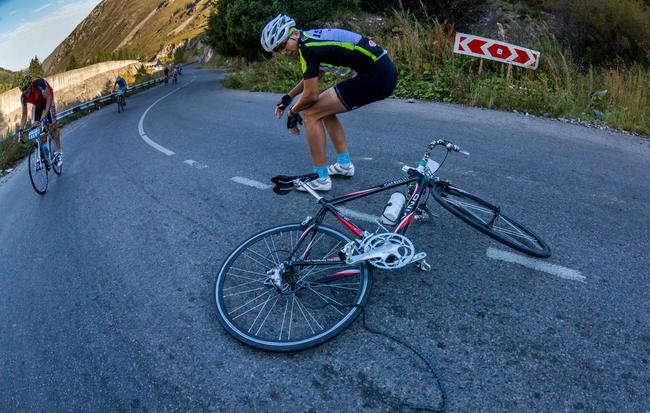 Shutterstock
Shutterstock
Vicki Barclay was feeling off. The PhD, 34, a research scientist and mountain bike racer for Stan’s Notubes Elite Women’s team recalls that “for about a week I just didn’t feel right. I felt like I had bad indigestion and discomfort on my left side.” It never occurred to her that it could be a serious blood clotting condition, called Deep Vein Thrombosis; instead, she chalked it up to previous injuries, travel and stress. But then, things got much worse. “I raced a cyclocross race that Saturday and had a pounding headache. I tried to ride the next day and was insanely breathless. Then I drove ten hours to do a ride I’d planned in Pisgah, North Carolina, but I was so weak I couldn’t even get on my bike. I ended up blacking out and going to the hospital.”
The diagnosis was multiple blood clots (pulmonary emboli) in her lungs and a large clot (deep vein thrombosis) in her right leg. Barclay was admitted to the hospital, put on blood thinners and forbidden from mountain biking for the foreseeable future. “I can’t believe it happened to me. I should recover, albeit with a few bits of dead lung, but I went from easily completing multiple workouts a day to struggling to walk without help. The lesson I learned from this experience is not to always push through pain; sometimes stopping and listening to your body can save your life.”
So can knowledge of your risks, adds Barclay, which she wants more riders—especially women—to have.
DVT Risk Factors
Your genes. About 5 to 8 percent of the population are born with a genetic predisposition for blood clotting disorders. This alone won’t necessarily lead to DVT or pulmonary embolism, though, unless triggered by another risk factor.
Injuries. Damage to a vein caused by bone fractures, severe muscle injury, and/or surgery raise your risk—a good thing to keep in mind should you have a bad crash.
Slow blood flow. Pay close attention to this one! If you’re well-conditioned, you likely already have a low resting heart rate. So when you’re especially immobile or sedentary, your calf muscles (which are known in medical circles as your second heart) don’t contract to assist circulation and blood can pool in your extremities, raising your risk. Sitting in a cramped plane for a long flight is an obvious one, but research shows that more people are being admitted to the hospital for DVT because of long hours sitting at their desk jobs.
Dehydration: reduces your blood plasma volume, thickening your blood and slowing circulation. It also raises your clotting risk.
Hormones. Estrogen via birth control and hormone replacement therapy can increase your blood’s clotting ability, as can pregnancy, though DVT is by no means a single-gender issue. Bicycling’s own gear editor Matt Phillips was struck with a DVT in early 2014, and ended up on blood thinners for four months. “It was likely a combination of dehydration and travel. I did a hard Grand Fondo in Italy, got on a plane and flew home. Did another long airline trip a few days later and ended up with nagging pain in my soleus that I couldn’t stretch or massage out,” says Phillips, who sought urgent care after about 30 days when it still hadn’t cleared up. “Luckily it didn’t break loose and become a pulmonary or aortic embolism,” he says.
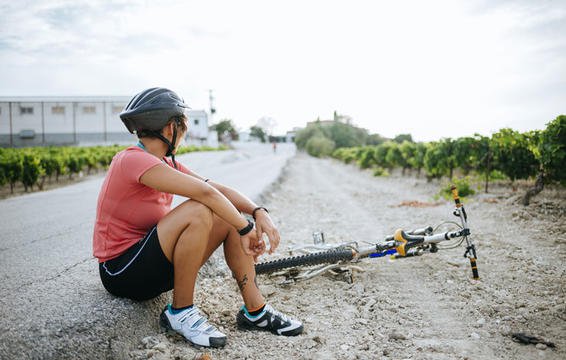 Shutterstock
Shutterstock
Hindsight is 20/20
Barclay was on birth control pills, and eight weeks prior to her hospitalization, she’d crashed in a pro XC race and cracked four ribs. Six weeks after breaking her ribs, she flew to Utah and rode with her teammates at altitude, which is naturally dehydrating. Finally, as a well-trained endurance athlete, Barclay has a low resting heart rate.
“She had the perfect storm—a tsunami, really—of risk factors,” says exercise physiologist Stacy Sims, PhD, author of ROAR, How to Match Your Food and Fitness to Your Unique Female Physiology for Optimum Performance, Great Health, and a Strong, Lean Body for Life. “Because she’s a healthy, young, athletic woman, she’s used to pushing through discomfort and pain and not inclined to think that something is wrong with her even when she’s getting warning signs.”
That can have severe consequences. One of Sims’ longtime Ironman acquaintances also recently developed DVT and was put on Warfarin (a blood thinner) to clear it. Problem was that she was allergic to the medicine and ended up with sepsis below the clot in her lower leg. She ultimately had to have part of her leg amputated.
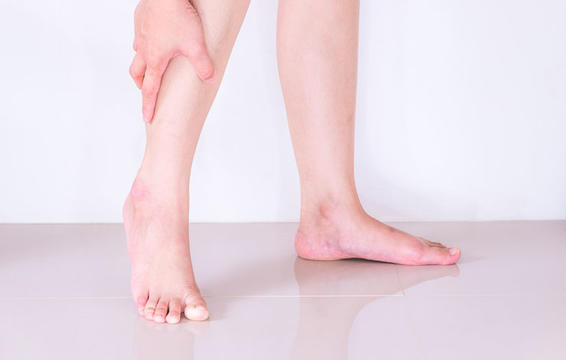 Shutterstock
Shutterstock
DVT Signs and Symptoms
As a cyclist, you likely have your share of aches and pains now and then, so it’s easy to ignore a little nagging ache. But you shouldn't ignore these, especially if you have risk factors for DVT. Symptoms and signs of DVT may include the following and should be checked by your doctor.
Swelling
Leg pain, similar to a cramp or pull
Tenderness
Warmth and/or redness of the skin
Skin discoloration of the affected leg, may look reddish blue
Also be aware of signs of pulmonary embolism, which can occur without any signs of DVT (some DVT are “silent,” meaning they have no symptoms). Signs and symptoms of pulmonary embolism include the following and are considered a medical emergency—get help immediately.
Difficulty breathing
Chest pain or discomfort, generally worsens with deep breathing.
Coughing up blood
Racing heartbeat
Lightheadedness and/or fainting
An Ounce of Prevention...
So now you’ve got phantom calf pain and you’re convinced you can’t breathe, right? Believe us, we get it. To keep it in perspective, the actual risk for VTE (venous thromboembolism, such as DVT and pulmonary embolism) is still relatively low, with an estimated annual incidence of about 0.1 percent in the general population. However, even one incident can cause long-term complications, such as swelling and pain in the affected limb—and a pulmonary embolism can be fatal. So it’s vital to know how to lower your risk, what to watch for, and what to do should symptoms arise.
Rock the socks. We can debate the usefulness of compression socks for recovery and performance. But, they may help to prevent DVT because they apply gentle pressure across the foot, ankle and calf to promote circulation and prevent swelling. Wear a pair during long flights, especially if you’re flying after a race or big event where you might have elevated risk from dehydration and exertion. (Some experts, however, caution against using calf sleeves, as they can actually lead to swelling in the ankles and feet.)
Move your muscles. Get up and move as often as possible—at least every couple of hours, whether you’re on a long flight or at the office. While seated, exercise your calf muscles by doing toe and heel raises. “If you train, then sit all day or sit all day and then train, you need to make a conscious effort to stand up and walk around when you can throughout the day,” says Sims. “Circulation is your friend!”
Stay hydrated. Travel with a bottle and a sleeve of your favorite hydration drink, so you can fill up and stay hydrated during the flight and as you travel. Be sure to rehydrate after races and events, especially if you’re getting right into a car or plane to make the trip home afterward.
Suspension Tech: How does undamped suspension work
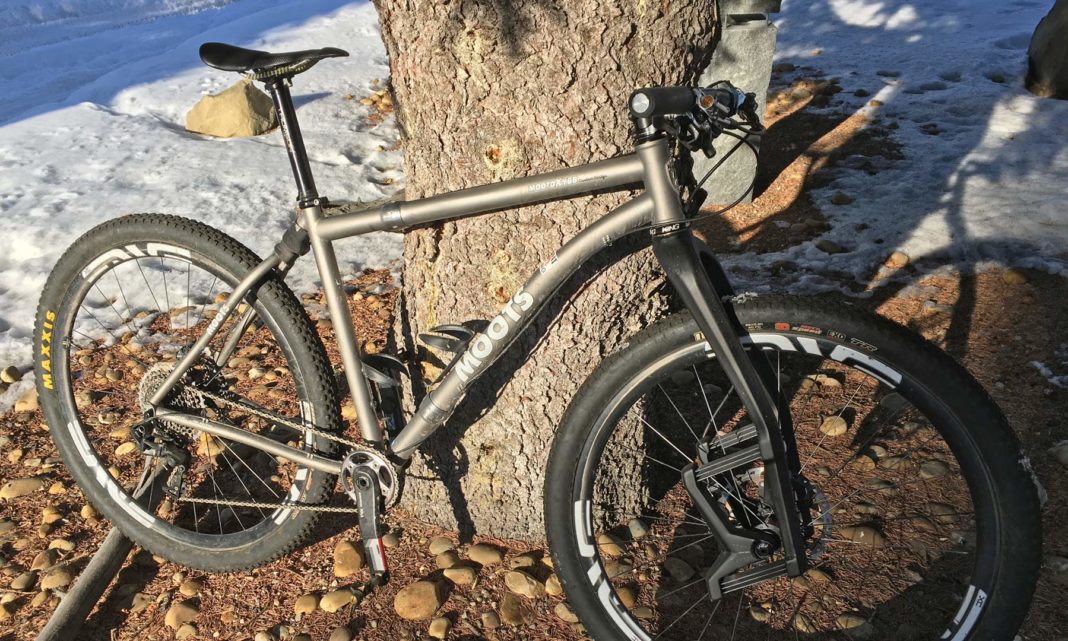
By: Cory Benson @ BikeRumor! SOURCE
Simple suspension isn’t limited to leaf spring forks, elastomer-equipped stems & double-decker flexing handlebars. Builders have been putting undamped suspension into bike frames for decades. More than meets the eye, we chatted with Moots about their iconic YBB design. And we found out that how their design deals with suspension damping takes a lot more factors into consideration.
How does undamped position work in a frame?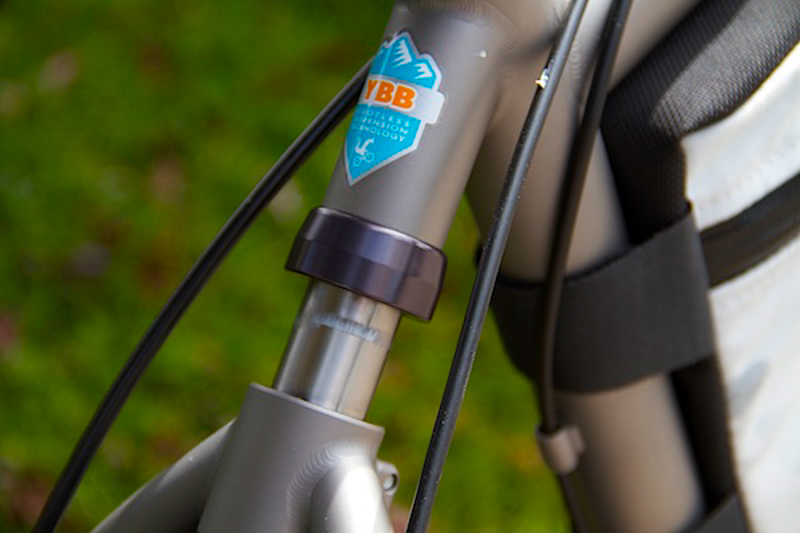
For the last couple of weeks we have been looking into what undamped suspension really is, plus why it makes sense in short travel forks and cockpit components, especially with growing gravel & adventure road disciplines that take on comparatively aggressive terrain. But undamped, or rather non-actively damped suspension isn’t limited to forks. We talked with Moots’ product development and production specialist Nate Bradley to get a look at the more complicated interactions that come into play in their YBB frame design.
The same idea as in forks is here – controlling the energy of an impact that hits the wheel, before it gets to the rider. What’s unique in Moots’ YBB frame design is that even though we see a small slider with a concealed spring in the monostay just above the rear wheel, it is actually the frame itself – the titanium tubes of the chainstays from bottom bracket to rear axle – that act as the spring in the suspension. Just think if you took that YBB assembly in the monostay away, the frame wouldn’t fall apart, it would just become overly flexible since the chainstays’ spring is effectively undersized. (Take the leaf springs out of the Lauf on the other hand and there is nothing to support the fork to the front axle.)
That YBB assembly has a “coil die spring that controls compression and dictates rebound along with an elastomer that helps minimize the bounce of the coil spring.” Inside of the YBB wishbone at the top of the seatstays is a free floating (not fixed on either end) coil spring, which has the urethane elastomer fixed to each of its ends. Together, the coil-over-elastomer combo helps control the rate at which the chainstays flex. They are supplementary to the main springs, which are the titanium chainstays themselves.
The elastomer also prevents the coil spring from bouncing back too quickly. In the end, this allows Moots to engineer a fixed amount of rebound damping into the rear wheel suspension system, in a simple and lightweight way.
Does a passively damped frame only work for short travel?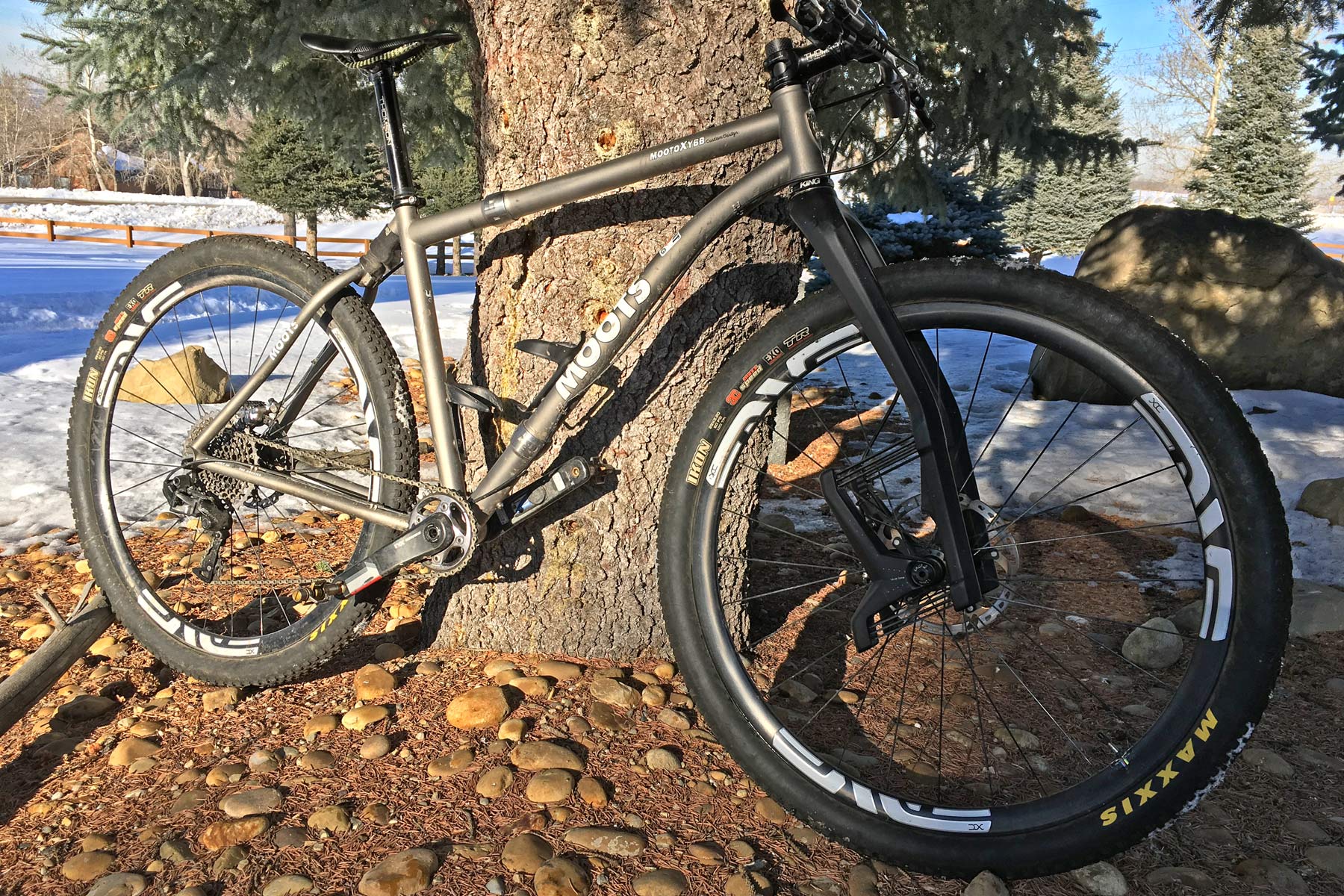
As with undamped front suspension, the goal is the same in the frame – to distribute peak impacts over a longer period of time and allow the wheel to move up and down independent of the rider. “The goal is that the YBB takes the edge off the impact, separating the vibrations/impacts from the rider’s rear end and what the rear wheel faces along the trail.” The chainstays flex, the YBB compresses & rebounds, and the tire stays planted on the trail.
Moots acknowledges this solution reaches a limit pretty quickly. It’s easy for these types of designs and materials to get overwhelmed, at which point the YBB loses its simple comfort & compliance benefits. Nate says “the longer the travel gets, the more progressive the system would need to be to avoid unwanted bounce” or on the contrary they would have to build an “overly stiff and robust” frame to make it work.
Why not chose an actively damped design in the first place?
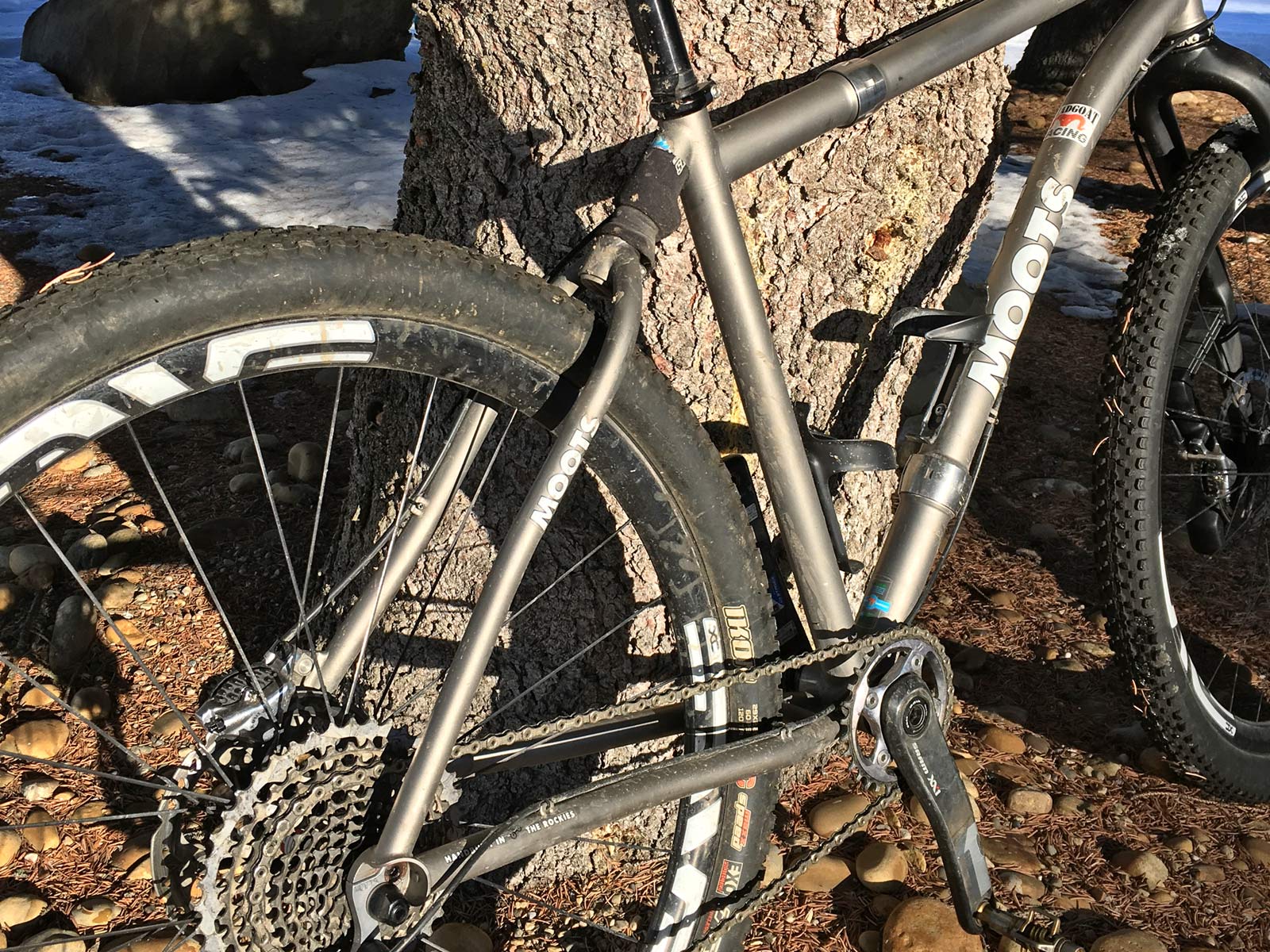
Moots has built YBB softail bikes since the late 1980s, and when they transitioned to titanium the material spring characteristics worked even better. Moots has also built a number of traditional pivoting & actively damped suspension frames over the years. But they stand by the YBB softail as a simple, serviceable solution that adds comfort without sacrificing much in terms of weight, pedaling efficiency, durability, or even aesthetics over a hardtail. A Moots YBB adds only a couple hundred grams over their comparable rigid hardtails, much less than a full suspension design. And while it does require some maintenance in the roughly bi-annual replacement of the titanium slider and its rubber seal, that is much less than suspension designs with hydraulic dampers, pivots & bushings. (And as you can see with this YBB and its neoprene boot to keep mud off the slider, if protected that service interval can be extended even further.)
And it doesn’t necessarily need to be limited just just to titanium (Moots themselves developed and built the YBB in steel first.) Plenty of other bikes incorporate flexing stays, like the old Castellano designed Fango in aluminum (that grew into a Ti Potts version more recently) and scores of modern bikes in carbon from the cobble-crushing Pinarello K8s to the XC & trail-riding Cannondale Scalpels that helped popularize carbon flex stays. In these shorter travel applications it seems like building the desired spring rate into the material of the chainstays is the only limiting factor.
How do you tune the passively damped suspension for each rider?
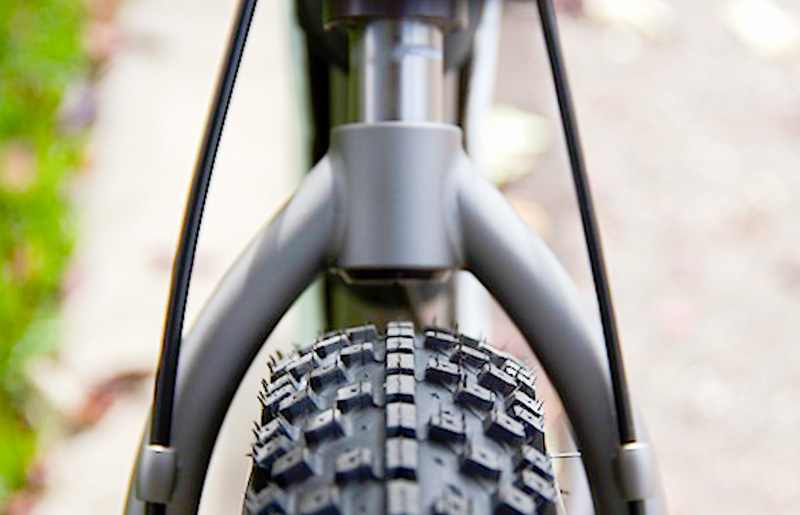
To design their passively damped suspension, Moots can size the chainstays to achieve the base spring rate they want – with six different spring rates generally available to start, and then varying tubing wall thickness to get the spring/flex they’re looking for. Then they can even preload the spring of the frame, so the YBB unit itself is effectively in its neutral state with the rider sitting on the bike.
Varying spring rates for the coil spring in the YBB allows Moots to control or damp the speed at which the suspension compresses. And lastly by choosing the urethane composition of the elastomer bumper Moots can determine how quickly the coil spring rebounds, kicking back through the chainstay spring.
Final thoughts on undamped travel in frame, fork & component design?
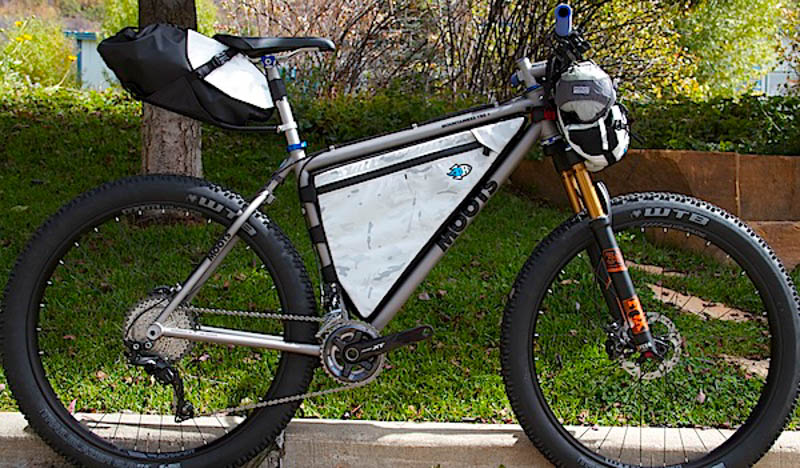
Nate tells us Moots isn’t “moving away from using undamped suspension in our frames anytime soon”. While you will find plenty of people “on both sides of the fence that like/dislike undamped suspension in forks and frames” there are certainly good arguments and applications for it. And those may even be expanding with the growth of gravel and adventure riding. While Nate has seen bars, stems, seatposts, wheels, grips, pedals & more try in some capacity to add simplified suspension “besides a frame, fork, and maybe a properly executed seatpost – a decent set of tires with the correct air pressure will have a greater effect for comfort for the rider than the marginal gains of other components.”
So that’s where we’ll leave it for undamped suspension design…for now. You aren’t likely to get a long travel downhill bike anytime soon that relies solely of flexing leaf springs in the fork or flexing chainstays in the frame. But if you are riding less technical terrain like cobbles, gravel and smooth-ish trails you may be able to find a simplified, undamped suspension setup that works for you where you won’t have to worry about maintaining hydraulic damping circuits.
Van Vleuten: The relentless rainbow dreamer
Original Post: Cycling News
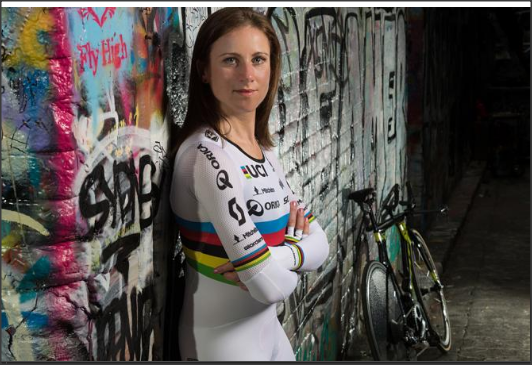
There was a time, around the mid-2000s, when Annemiek van Vleuten was living in cramped student accommodation, working a 32-hour week, and racing on a salary of just €100 a month. If it’s tough at the top, as the old adage goes, then it’s a hell of a lot tougher at the bottom.
Almost a decade later and the 35-year-old is striding confidently through the Hilton Hotel in downtown Adelaide, greeting fans and mingling with the cycling public who affectionately call out, ‘Annemiek’ before instinctively positioning themselves for selfies.
That previous world, when Van Vleuten was just starting out on the Vrienden van het Platteland team, must seem like a galaxy away. Now, the world time trial champion is at the pinnacle of the sport but, as she tells Cyclingnews’ Daniel Benson, she’s far from finished and just as determined as ever to build on her ever-improving legacy.
This year, Van Vleuten will embark on perhaps her most challenging season yet as she aims to dovetail her love of road racing and time trialling with ambitions of success on the track at the World Championships. Given the increasing specialisation and competitiveness that has developed in women’s cycling, it will be no easy venture but the Mitchelton-Scott leader is anything but fazed.
"I only want to take on a challenge if it’s really serious," she says with a smile that belies her undoubted hunger.
So, this year Van Vleuten will use the early-season races in Australia – she is currently racing the Herald Sun Tour – as building blocks before switching to individual pursuit preparations in February. Her track plans mean that she will miss the majority of the Classics – barring the Tour of Flanders – before returning for a serious tilt at the Giro Rosa and then a three-pronged attack at the UCI Road World Championships in the autumn, in which she will race the team time trial, the individual time trial and then the road race. She is nothing if not eager.
"The idea for the track actually started three years ago when the mechanic at Mitchelton-Scott tried to convince me that I should target it," she says, before stating that her goals for the Tokyo 2020 Olympic Games are likely to be based on the road.
"The mechanic, he worked with some of the girls on the track and I was a good prologue rider but I found that it was hard if you had no track experience. It’s not super-technical but there’s a lot involved. I like challenges and maybe this gives me a different approach to the start of the season."
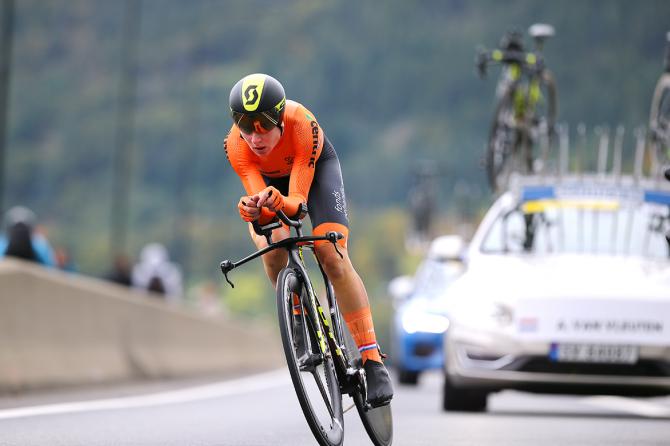
Indeed, Van Vleuten was once recognized as a fine prologue rider and was a regular fixture at the podium celebrations on the opening days of stage races. Then something changed but, unlike a switch being turned on, it was a slow gradual process of improvement that started around 2015, when she began preparing for the following season's Olympics. Her subsequent crash in the road race has been well documented but it was the months of preparation in the build-up to Rio that really saw her change.
"I saw the course for the Olympics and realised I had to become a better climber if I was to really try and target the race," she says. "I did a lot more altitude camps and really worked on my climbing, and that really was a turning point in my career."
It wasn’t just her climbing that was given a thorough examination. Although she was proficient and successful against the clock, she wasn’t quite world class over longer courses. A move to the Australian team in 2016 provided her with the necessary equipment and the platform to train properly. It may sound clichéd, but sometimes a change of kit and a new environment can work wonders for a rider.
"Another point is that I have a time trial bike at home now. That made a massive difference. Before, on other teams, I never had a TT bike at home, so I could never train on it. So now I can fly to altitude and bring my time trial bike. When I was on previous teams that wasn’t even allowed. People ask me how I became a stronger time triallist, well, being able to train twice a week on my time trial bike made a huge difference."
With her skillset complete, Van Vleuten has the air of someone who believes she is now ready for anything. She doesn't come across as arrogant – the opposite in fact – but whether it's track, Classics, stage races, time trials, or the cyclo-cross she dabbles in, anything seems possible.
"After I come back from the track, the Ardennes are a big goal for me but if you ask me what my two main goals are for this year, it’s the Giro and the Worlds. I’m really pumped for the Giro this year after messing up last year. I’m really looking forward to racing on the Zoncolan on the second last stage and there’s a really hard time trial. I’m going to love targeting it with my team. We’re all really motivated," she says.
"For the Worlds on the road I’m looking forward to targeting the road race and the time trial. That’s my main focus. The triple is possible but that’s not a main goal. The goal for me is to win a rainbow jersey."
The road Worlds, however, are a long way off on the horizon and Van Vleuten is still competing in Australia as part of the Herald Sun Tour.
She has based herself here for several months now, enjoying the warm weather, the relaxed nature of living, and the adventure of being away from her native home. In a sense, it was her move to Mitchelton-Scott in 2016 that created the freedom in which she could flourish.
"The team has really helped me develop. In the past, I was focused on training and numbers. This team feels more like a home and I enjoy it more," she says. "I’ve learned to enjoy more about my life in cycling. So, while I’ve been here in Australia for three months and had a lot of fun, if you check my training files I’ve done a crazy amount of work here too."
It’s not just the team’s nationality Van Vleuten has a fondness for.
“I love it here, I love Australia,” she beams. “I started my holiday in November. When I got to Melbourne I parked my bike for three weeks and I traveled around with my best friend, who I’ve known since I was three years old. We had great fun. We went hiking, saw the Great Barrier Reef, and did camping with spiders and snakes around us. I was totally out of my comfort zone but I loved it.”
Whether it’s on the track, the road, or the mud and sand of ‘cross, it’s difficult to imagine Van Vleuten ever out of her comfort zone when it comes to cycling. So much has happened to her since she left that tiny student room in 2008 but, given her appetite for a challenge, few would bet against her rainbow dreams becoming a reality once more. Whether it's on the track, the road, or both.
